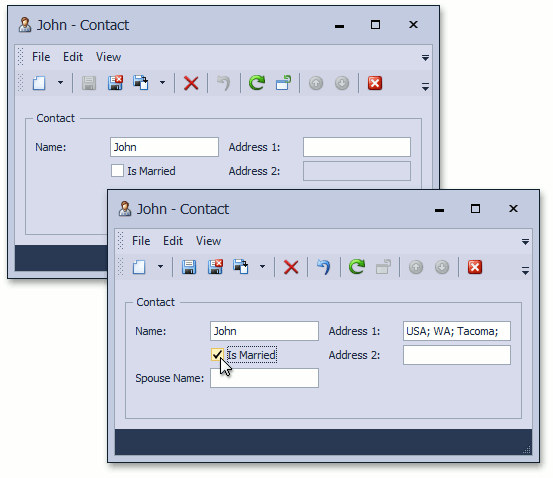Disable and Hide Property Editors Based on a Business Rule
- 4 minutes to read
XAF is shipped with the Conditional Appearance module. One of the features provided by this module is an option to disable/enable and show/hide Property Editors based on business rules. This topic contains step-by-step instructions that demonstrate how the Conditional Appearance module can be used for this purpose. Several appearance rules will be created to dynamically hide and disable Property Editors.

Note
See more examples on how to use the Conditional Appearance in the Feature Center demo installed with XAF in the %PUBLIC%\Documents\DevExpress Demos 23.2\Components\XAF\FeatureCenter.NETFramework.XPO folder, or refer to the Feature Center demo online.
Use the DevExpress v23.2 XAF Template Gallery template to create a new XAF Solution. Add the Conditional Appearance module to the module project. To do this, open the MySolution.Module\Module.cs (Module.vb) file and add the following code to the Module constructor:
using DevExpress.ExpressApp.ConditionalAppearance;
// ...
namespace MySolution.Module {
public sealed partial class MySolutionModule : ModuleBase {
public MySolutionModule() {
// ...
RequiredModuleTypes.Add(typeof(ConditionalAppearanceModule));
}
}
}
In .NET Framework projects, you can alternatively invoke the Module Designer for the module project and drag the ConditionalAppearanceModule item from the Toolbox to the Required Modules panel.

Declare the Contact business class in the solution’s Module Project. You can use the XPO Business Object template for this purpose. Replace the auto-generated class’ code with the following.
[DefaultClassOptions]
[ImageName("BO_Person")]
public class Contact : BaseObject {
public virtual string Name { get; set; }
public virtual bool IsMarried { get; set; }
public virtual string SpouseName { get; set; }
public virtual string Address1 { get; set; }
public virtual string Address2 { get; set; }
}
// Make sure that you use options.UseChangeTrackingProxies() in your DbContext settings.
The sample Contact class contains five properties: Name, IsMarried, SpouseName, Address1, Address2.
To ensure that the SpouseName Property Editor is only displayed when a contact is married, add the following AppearanceAttribute attribute. The IsMarried property should be decorated by the ImmediatePostDataAttribute attribute to ensure that the SpouseName Property Editor is immediately hidden when a user changes the IsMarried value.
using DevExpress.ExpressApp.ConditionalAppearance;
using DevExpress.ExpressApp.Editors;
//...
[ImmediatePostData]
public bool IsMarried {
// ...
}
[Appearance("Single", Visibility = ViewItemVisibility.Hide, Criteria = "!IsMarried", Context="DetailView")]
public string SpouseName {
// ...
}
The appearance rule, declared by the following attribute, ensures that the Address2 Property Editor is enabled only if the Address1 field is filled. Otherwise, the Address2 Property Editor should is disabled.
[ImmediatePostData]
public string Address1 {
// ...
}
[Appearance("AddressOneIsEmpty", Enabled = false, Criteria = "IsNullOrEmpty(Address1)", Context="DetailView")]
public string Address2 {
// ...
}